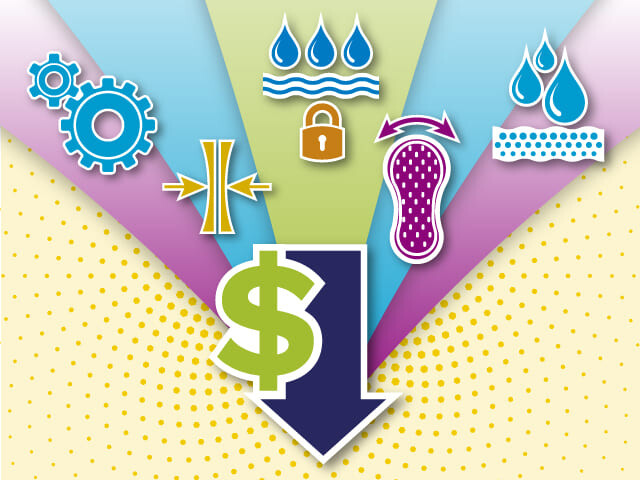May 9, 2024 - 3-5 Minutes
The Cost of Incontinence … for Absorbent Hygiene Users and Beyond

Urinary and fecal incontinence place a financial burden on those that manage the condition. But there are other costs, such as emotional wellbeing, loss of wages, and productivity. Even the environment is impacted. Absorbent hygiene products can be used—and manufactured—to lessen these costs.
Without a doubt, living with incontinence takes a toll on an individual’s physical and emotional wellbeing. But it can also cause a heavy financial burden. There are a variety of costs that come with the condition, and some are difficult to budget for.
Monetary Impacts of Incontinence
Direct costs: Most obvious is the purchase of absorbent hygiene articles. For some, there are also medical expenses for diagnosis and, when possible, treatments such as surgical procedures or prescriptions. Less obvious are the other products used to help manage and conceal the condition. These can include plastic bags, creams and ointments, tote bags, and additional clothing.
Indirect costs: Lost wages by affected individuals and/or caregivers due to absenteeism brought on by their incontinence. Similarly, there can be lost productivity during work hours to manage the condition (e.g., change soiled products). Sufferers also face additional laundry costs for soiled clothing and bed linens. There can also be medical expenses to care for other health issues that may result, such as skin conditions.
These costs are of great concern for older adults living on a fixed income. In countries where little to no government assistance is available, many individuals are struggling to pay for products. Finding affordable, high-quality incontinence products also impacts the disposable income of:
- Younger and middle-aged adults who wish to maintain their active, social lifestyles
- Family members who serve as caregivers and are responsible for purchasing products
Not everyone who has incontinence considers hygiene products to be worth the cost. To put it in perspective: Research indicates that the income threshold at which the purchase of adult incontinence products is triggered is three times higher than that of baby diapers.1
For populations in many emerging countries, disposable income is often below that threshold—though this is changing slowly. Even in more mature countries, a significant fraction of people in need of adult incontinence products is probably also below that threshold.
Another factor to consider: Some who do opt to use disposable articles may decide not to change soiled products as often as recommended. This management approach puts the incontinent adult at risk for other high-cost health concerns. Examples include skin infections and incontinence-associated dermatitis (IAD).
Other Costs of Incontinence
Emotional toll: The condition affects people’s mental wellbeing in many ways. One is the fear of having leaks. Another is the concern that others will notice their condition, whether by spotting products being worn, or through stains or smells. Shame is not uncommon, fueled by worry that work or personal relationships would suffer if their condition were discovered.
Unsurprisingly, many also struggle with anxiety over finances and how to pay for needed medical care and hygiene products, as well as other items used to manage their condition.
Environmental impact: Because they are disposable, hygiene products pose a cost for the environment as well. Resources are consumed to make a host of single-use items, which are then discarded. So far, articles that can be composted or recycled are only a fraction of those sold. Most find their end of life in landfills and incineration.
Knowledge of the waste generated is another factor that can weigh on incontinent adults. Many look toward more sustainable solutions, but few are willing to risk any reduction in effectiveness in order to be more sustainable. The consequences of product failure are simply too disconcerting.
Overcoming the Costs: How Article Producers Can Help
Fortunately, there are several ways that absorbent hygiene producers can help. Working with knowledge partners, manufacturers can explore new product designs, applications, and other options that can contribute to overall affordability, performance, and peace of mind for product users.
Product price: Switching to the right adhesives in adult diapers and incontinence pads may result in the producer’s ability to use less-costly substrates or remove the need for some materials altogether. This can help with managing production expense, reducing waste, increasing line speed, and ultimately decreasing the consumer outlay at the point of sale.
Thinner profiles: Reducing the thickness of substrates can help lower material costs. Slimmer products, such as those with less fluff, also decrease the chance of articles being noticed by others.
Greater absorbency: Increasing the capacity of product cores to hold fluid aids in controlling the need for product changes and the generation of waste. One tactic to further this goal is ensuring that product designs support the ability to absorb evenly and fully.
Leak reduction: Features which help prevent leakage inevitably lead to fewer clothing changes and less laundering. They can also alleviate the user’s fear of their incontinence being revealed in embarrassing ways.
Effective pad attachment: When pads for light urinary incontinence stay in place, they are most effective. This leads to fewer leaks, increased comfort, and a smoother profile beneath the clothing.
Take advantage of all that Bostik can do for you. Our experts can help you learn more about your options for period care and light incontinence pad adhesives. Contact a Bostik expert today!
1 Euromonitor, 2019.
©2024 Bostik, Inc. All Rights Reserved
All information contained herein is believed to be accurate as of the date of publication, is provided “as-is” and is subject to change without notice. To review our full U.S. Legal Disclaimer, visit: https://bostik.com/us/en_US/privacy-policy/legal-disclaimer
